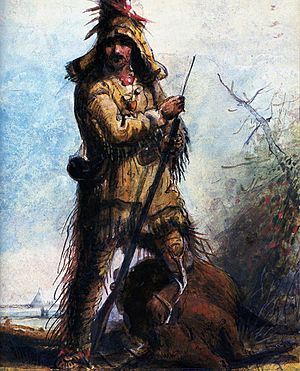Old Bill Williams facts for kids
Quick facts for kids
"Old Bill" Williams
|
|||||||||
|---|---|---|---|---|---|---|---|---|---|

Old Bill Williams by Alfred Jacob Miller
|
|||||||||
| Born | January 3, 1787 |
||||||||
| Died | March 14, 1849 (aged 62) Southern Colorado along the Rio Grande
|
||||||||
| Cause of death | Killed by Ute warriors | ||||||||
| Burial place | Williams, Coconino County, Arizona | ||||||||
| Nationality | American | ||||||||
| Occupation | Mountain man, trapper, guide, interpreter | ||||||||
| Spouse(s) | A-Ci'n-Ga, name means Wind Blossom | ||||||||
| Parent(s) | Joseph Williams, Sarah (Musick) Williams | ||||||||
|
|||||||||
William Sherley "Old Bill" Williams (January 3, 1787 – March 14, 1849) was a noted mountain man and frontiersman. He served as an interpreter for the government, and led several expeditions in the West. Fluent in several languages, he lived with the Osage, where he married the daughter of a chief, and with the Ute.
Contents
Biography
Early life and education
Williams was born on January 3, 1787 on Horse Creek, a branch of the Pacolet, under Skyuka Mountain in Polk County, North Carolina. He liked to explore and learned to trap animals for their furs, and found he had a gift for languages. Williams was the son of Joseph Williams who was invited to settle in what is now Missouri by Spanish lieutenant governor of Upper Louisiana, Zenon Trudeau in about 1795.
Career
Williams was a master fur trapper and trail guide, becoming fluent in several Native American languages among the tribes he knew the best. He served as a sergeant and scout with the Mississippi Mounted Rangers during the War of 1812 and, as he encountered local tribes, learned their languages and customs. His ability to communicate in the different languages made him valuable to the government and the military for tribal negotiations.
After military service, Williams became a Protestant preacher, and worked with some of the Native American tribes, moving west from Mississippi to frontier areas. During his early years, he lived with the Osage Indians in Missouri, and later with the Ute Indians. While residing with the Osages he worked with the Harmony Mission to the Osages. He translated the bible into the Osage language and was the interpreter for the 1825 treaty between the Osage and the United States.
Marriage and family
He married A-Ci'n-Ga, a full-blood Osage woman. They became the parents of two daughters. He assimilated into the Osage as a fur trapper and never returned to European-American life, however he did send his half-Osage daughters to it. Williams was named "Lone Elk" by numerous Native American tribes.
William had two children with A-Ci'n-Ga, whose name means "Wind Blossom." The first-born was Mary Ann, who was born in 1814. The second, Sarah, was probably born around 1816.
After his wife A-Ci'n-Ga died, he sent his daughters to attend school in Kentucky. His daughter Mary Williams married John Allan Mathews of Kentucky who operated multiple trading ventures with the Osage. After her death Mathews married Williams' younger daughter Sarah. Sarah Williams (Mathews) was the grandmother of historian John Joseph Mathews.
John Joseph Mathews, Williams' great-grandson, became a noted author of the Osage, served on the Tribal Council, and helped found the Tribal Museum in 1938.
Later career
By 1822 he was working as an independent trapper, and also guided travelers through the far western frontier of the time. He was a respected figure among the mountain men and worked with many, including Uncle Dick Wooton, Joe Walker, Alexis Godey, George Nidever, Zenas Leonard, Antoine Leroux, Lucien Maxwell, William Thomas Hamilton, Dick Owens, Kit Carson, and, infamously, with John C. Frémont on his fourth expedition. As an Indian fighter, he had noted encounters with Blackfeet, Apache, Comanche, and Modoc Indians.
Williams traveled through a wide territory, including Texas, California, the Rocky Mountains, Yellowstone, the Santa Fe Trail, Arizona, and the Colorado and Little Colorado River regions. Williams was with Joseph Walker's historic expedition which found, but did not enter, the Yosemite Valley.
Frémont's Fourth Expedition controversy
In November 1848 Frémont sought Williams to lead a transcontinental railroad survey into Sangre de Cristo range after other mountain men had rejected Frémont's proposition. Once the team entered the mountains, Williams changed his mind due to the heavy early snowfall. He warned the party against continuing and insisted on a southern route. Frémont continued, and the expedition was defeated within the San Juan Mountains, where 10 expedition members died of starvation and exposure.
Death
Williams died shortly afterward at age 62 in March 1849 when ambushed and killed by Ute warriors. He was returning to Taos from helping to retrace the expedition trail to try to find survivors.
Legacy and honors
"Old Bill" is portrayed in an 8-foot-tall bronze sculpture by B. R. Pettit, erected in 1980 in Bill Williams Monument Park in Williams, Arizona. In addition to the park and town, several places and organizations in Arizona were named after him: Bill Williams River and Bill Williams Mountain, the Bill Williams Mountain Men of Williams, Arizona chapter of the Pioneer Club, and the Chautauqua Program: "Rendezvous With Old Bill Williams". He was portrayed by Slim Pickens in a Disney series entitled The Saga of Andy Burnett.


